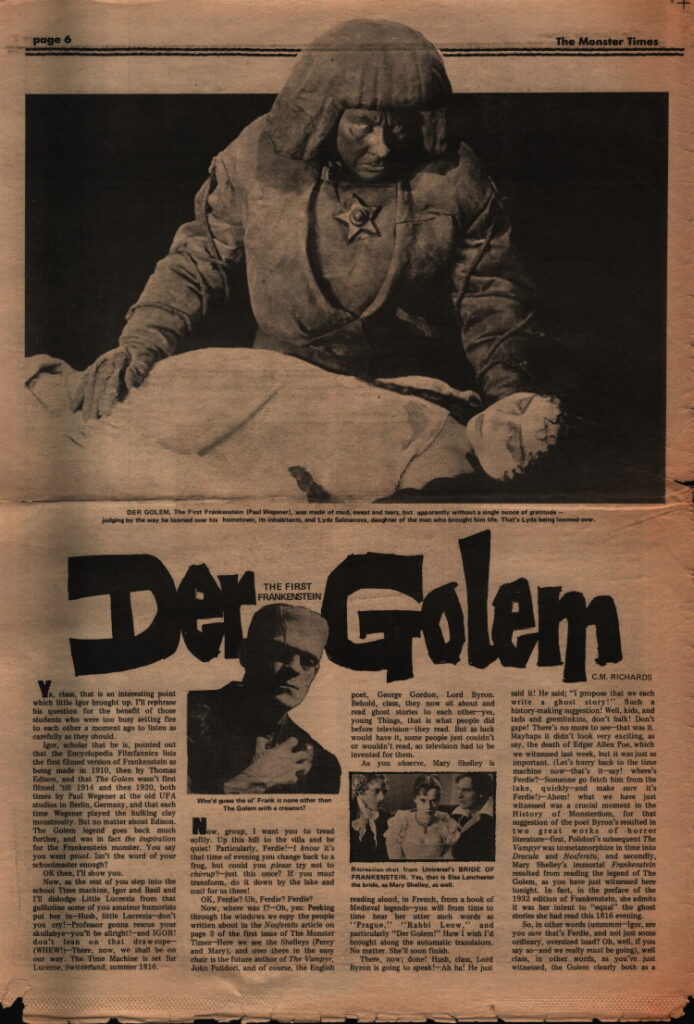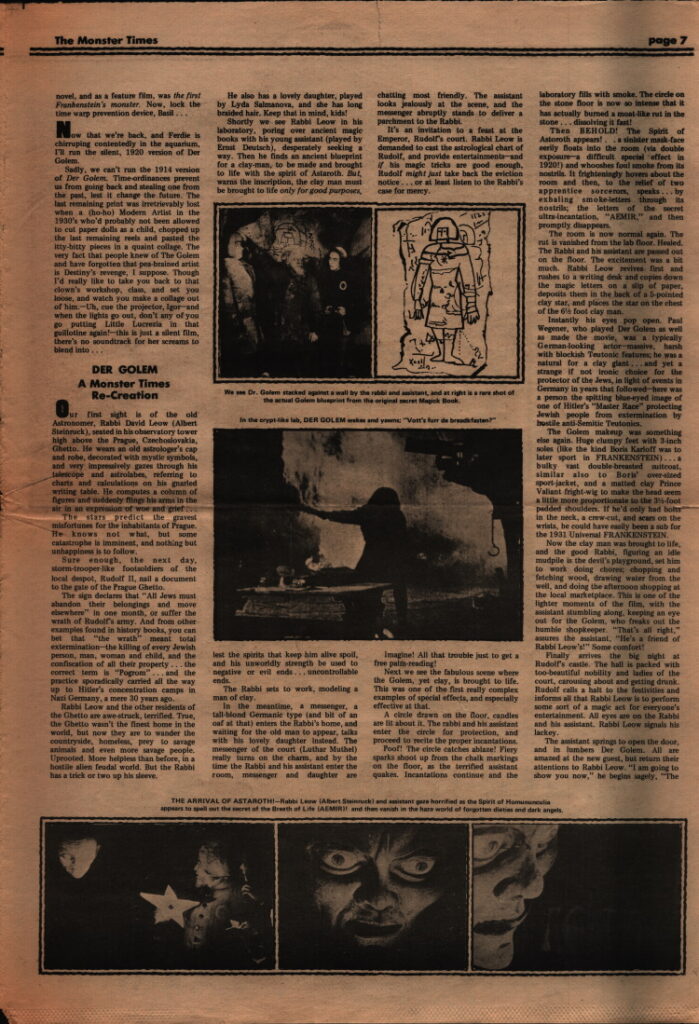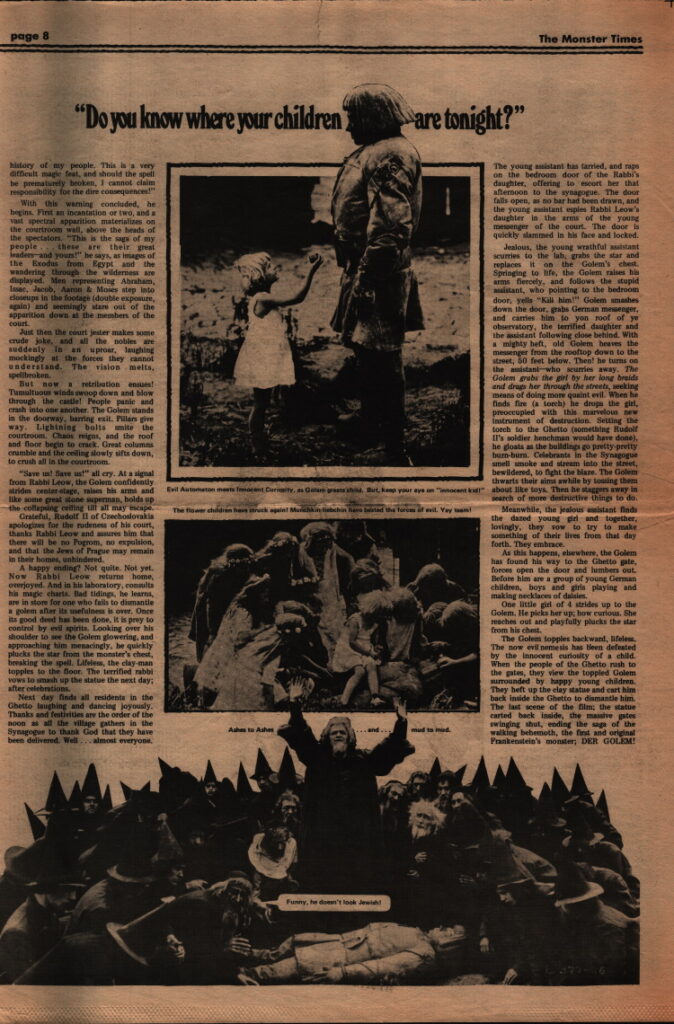
Ya, class, that is an interesting point which little Igor brought up. I’ll rephrase his question for the benefit of those students who were too busy setting fire to each other a moment ago to listen as carefully as they should.
Igor, scholar that he is, pointed out that the Encyclopedia Filmfannica lists the first filmed version of Frankenstein as being made in 1910, then by Thomas Edison, and that The Golem wasn’t first filmed ’till 1914 and then 1920, both times by Paul Wegener at the old UFA studios in Berlin, Germany, and that each time Wegener played the hulking clay monstrosity. But no matter about Edison. The Golem legend goes back much further, and was in fact the inspiration for the Frankenstein monster. You say you want proof. Isn’t the word of your schoolmaster enough?
OK then, I’ll show you.
Now, as the rest of you step into the school Time machine, Igor and Basil and I’ll dislodge Little Lucrezia from that guillotine some of you amateur humorists put her in-Hush, little Lucrezia-don’t you cry!-Professor gonna rescue your skullabye-you’ll be allright!-and IGOR! don’t lean on that draw-rope(WHEW!)-There, now, we shall be on our way. The Time Machine is set for Lucerne, Switzerland, summer 1816.
Now, group, I want you to tread softly. Up this hill to the villa and be quiet! Particularly, Ferdie!-I know it’s that time of evening you change back to a frog, but could you please try not to chirrup?-just this once? If you must transform, do it down by the lake and wait for us there!
OK, Ferdie? Uh, Ferdie? Ferdie?
Now, where was I?-Oh, yes: Peeking through the windows we espy the people written about in the Nosferatu article on page 3 of the first issue of The Monster Times-Here we see the Shelleys (Percy and Mary), and over there in the easy chair is the future author of The Vampyr, John Polidori, and of course, the English poet, George Gordon, Lord Byron. Behold, class, they now sit about and read ghost stories to each other-yes, young Things, that is what people did before television–they read. But as luck would have it, some people just couldn’t or wouldn’t read, so television had to be invented for them.
As you observe, Mary Shelley is reading aloud, in French, from a book of Medieval legends-you will from time to time hear her utter such words as “Prague,” “Rabbi Leow,” and particularly “Der Golem!” How I wish I’d brought along the automatic translators. No matter. She’ll soon finish.
There, now; done! Hush, class, Lord Byron is going to speak!-Ah ha! He just said it! He said; “I propose that we each write a ghost story!” Such a history-making suggestion! Well, kids, and tads and gremlinkins, don’t balk! Don’t gape! There’s no more to see that was it. Mayhaps it didn’t look very exciting, as say, the death of Edgar Allan Poe, which we witnessed last week, but it was just as important. (Let’s hurry back to the time machine now-that’s it-say! where’s Ferdie?-Someone go fetch him from the lake, quickly-and make sure it’s Ferdie!)-Ahem! what we have just witnessed was a crucial moment in the History of Monsterdom, for that suggestion of the poet Byron’s resulted in two great works of horror literature-first, Polidori’s subsequent The Vampyr was to metamorphize in time into Dracula and Nosferatu, and secondly, Mary Shelley’s immortal Frankenstein resulted from reading the legend of The Golem, as you have just witnessed here tonight. In fact, in the preface of the 1932 edition of Frankenstein, she admits it was her intent to “equal” the ghost stories she had read this 1816 evening.
So, in other words (ummmm-Igor, are you sure that’s Ferdie, and not just some ordinary, oversized toad? Oh, well, if you say so-and we really must be going), well class, in other words, as you’ve just witnessed, the Golem clearly both as a novel, and as a feature film, was the first Frankenstein’s monster. Now, lock the time warp prevention device, Basil…

Now that we’re back, and Ferdie is chirruping contentedly in the aquarium, I’ll run the silent, 1920 version of Der Golem.
Sadly, we can’t run the 1914 version of Der Golem. Time ordinances prevent us from going back and stealing one from the past, lest it change the future. The last remaining print was irretrievably lost when a (ho-ho) Modern Artist in the 1930’s who’d probably not been allowed to cut paper dolls as a child, chopped up the last remaining reels and pasted the itty-bitty pieces in a quaint collage. The very fact that people knew of The Golem and have forgotten that pea-brained artist is Destiny’s revenge, I suppose. Though I’d really like to take you back to that clown’s workshop, class, and set you loose, and watch you make a collage out of him.-Uh, cue the projector, Igor and when the lights go out, don’t any of you go putting Little Lucrezia in that guillotine again!-this is just a silent film, there’s no soundtrack for her screams to blend into…
DER GOLEM A Monster Times Re-Creation
Our first sight is of the old Astronomer, Rabbi David Leow (Albert Steinruck), seated in his observatory tower high above the Prague, Czechoslovakia, Ghetto. He wears an old astrologer’s cap and robe, decorated with mystic symbols, and very impressively gazes through his telescope and astrolabes, referring to charts and calculations on his gnarled writing table. He computes a column of figures and suddenly flings his arms in the air in an expression of woe and grief…
The stars predict the gravest misfortunes for the inhabitants of Prague. He knows not what, but some catastrophe is imminent, and nothing but unhappiness is to follow.
Sure enough, the next day, storm-trooper-like footsoldiers of the local despot, Rudolf II, nail a document to the gate of the Prague Ghetto.
The sign declares that “All Jews must abandon their belongings and move elsewhere” in one month, or suffer the wrath of Rudolf’s army. And from other examples found in history books, you can bet that “the wrath” meant total extermination-the killing of every Jewish person, man, woman and child, and the confiscation of all their property … the correct term is “Pogrom”… and the practice sporadically carried all the way up to Hitler’s concentration camps in Nazi Germany, a mere 30 years ago.
Rabbi Leow and the other residents of the Ghetto are awe-struck, terrified. True, the Ghetto wasn’t the finest home in the world, but now they are to wander the countryside, homeless, prey to savage animals and even more savage people. Uprooted. More helpless than before, in a hostile alien feudal world. But the Rabbi has a trick or two up his sleeve.
He also has a lovely daughter, played by Lyda Salmanova, and she has long braided hair. Keep that in mind, kids!
Shortly we see Rabbi Leow in his laboratory, poring over ancient magic books with his young assistant (played by Ernst Deutsch), desperately seeking a way. Then he finds an ancient blueprint for a clay-man, to be made and brought to life with the spirit of Astaroth. But, warns the inscription, the clay man must be brought to life only for good purposes, lest the spirits that keep him alive spoil, and his unworldly strength be used to negative or evil ends… uncontrollable ends.
The Rabbi sets to work, modeling a man of clay.
In the meantime, a messenger, a tall-blond Germanic type (and bit of an oaf at that) enters the Rabbi’s home, and waiting for the old man to appear, talks with his lovely daughter instead. The messenger of the court (Lothar Muthel) really turns on the charm, and by the time the Rabbi and his assistant enter the room, messenger and daughter are chatting most friendly. The assistant looks jealously at the scene, and the messenger abruptly stands to deliver a parchment to the Rabbi.
It’s an invitation to a feast at the Emperor, Rudolf’s court. Rabbi Leow is demanded to cast the astrological chart of Rudolf, and provide entertainments-and if his magic tricks are good enough, Rudolf might just take back the eviction notice … or at least listen to the Rabbi’s case for mercy.
Imagine! All that trouble just to get a free palm-reading!
Next we see the fabulous scene where the Golem, yet clay, is brought to life. This was one of the first really complex examples of special effects, and especially effective at that.
A circle drawn on the floor, candles are lit about it. The rabbi and his assistant enter the circle for protection, and proceed to recite the proper incantations.
Poof! The circle catches ablaze! Fiery sparks shoot up from the chalk markings on the floor, as the terrified assistant quakes. Incantations continue and the laboratory fills with smoke. The circle on the stone floor is now so intense that it has actually burned a moat-like rut in the stone … dissolving it fast!
Then BEHOLD! The Spirit of Astaroth appears! … a sinister mask-face eerily floats into the room (via double exposure-a difficult special effect in 1920!) and whooshes foul smoke from its nostrils. It frighteningly hovers about the room and then, to the relief of two apprentice sorcerers, speaks … by exhaling smoke letters through its nostrils; the letters of the secret ultra-incantation, “AEMIR,” and then promptly disappears.
The room is now normal again. The rut is vanished from the lab floor. Healed. The Rabbi and his assistant are passed out on the floor. The excitement was a bit much. Rabbi Leow revives first and rushes to a writing desk and copies down the magic letters on a slip of paper, deposits them in the back of a 5-pointed clay star, and places the star on the chest of the 62 foot clay man.
Instantly his eyes pop open. Paul Wegener, who played Der Golem as well as made the movie, was a typically German-looking actor-massive, harsh with blockish Teutonic features; he was a natural for a clay giant … and yet a strange if not ironic choice for the protector of the Jews, in light of events in Germany in years that followed-here was a person the spitting blue-eyed image of one of Hitler’s “Master Race” protecting Jewish people from extermination by hostile anti-Semitic Teutonics.
The Golem makeup was something else again. Huge clumpy feet with 3-inch soles (like the kind Boris Karloff was to later sport in FRANKENSTEIN)…a bulky vast double-breasted suitcoat, similar also to Borisover-sized sport-jacket, and a matted clay Prince Valiant fright-wig to make the head seem a little more proportionate to the 3/2-foot padded shoulders. If he’d only had bolts in the neck, a crew-cut, and scars on the wrists, he could have easily been a sub for the 1931 Universal FRANKENSTEIN.
Now the clay man was brought to life, and the good Rabbi, figuring an idle mudpile is the devil’s playground, set him to work doing chores; chopping and fetching wood, drawing water from the well, and doing the afternoon shopping at the local marketplace. This is one of the lighter moments of the film, with the assistant stumbling along, keeping an eye out for the Golem, who freaks out the humble shopkeeper. “That’s all right,” assures the assistant, “He’s a friend of Rabbi Leow’s!” Some comfort!
Finally arrives the big night at Rudolf’s castle. The hall is packed with too-beautiful nobility and ladies of the court, carousing about and getting drunk. Rudolf calls a halt to the festivities and informs all that Rabbi Leow is to perform some sort of a magic act for everyone’s entertainment. All eyes are on the Rabbi and his assistant. Rabbi Leow signals his lackey.
The assistant springs to open the door, and in lumbers Der Golem. All are amazed at the new guest, but return their attentions to Rabbi Leow. “I am going to show you now,” he begins sagely, “The history of my people. This is a very difficult magic feat, and should the spell be prematurely broken, I cannot claim responsibility for the dire consequences!”

“Do you know where your children are tonight?”
With this warning concluded, he begins. First an incantation or two, and a vast spectral apparition materializes on the courtroom wall, above the heads of the spectators. “This is the saga of my people … these are their great leaders and yours!” he says, as images of the Exodus from Egypt and the wandering through the wilderness are displayed. Men representing Abraham, Issac, Jacob, Aaron & Moses step into closeups in the footage (double exposure, again) and seemingly stare out of the apparition down at the members of the court.
Just then the court jester makes some crude joke, and all the nobles are suddenly in an uproar, laughing mockingly at the forces they cannot understand. The vision melts, spell broken.
But now a retribution ensues! Tumultuous winds swoop down and blow through the castle! People panic and crash into one another. The Golem stands in the doorway, barring exit. Pillars give way. Lightning bolts smite the courtroom. Chaos reigns, and the roof and floor begin to crack. Great columns crumble and the ceiling slowly sifts down, to crush all in the courtroom.
“Save us! Save us!” all cry. At a signal from Rabbi Leow, the Golem confidently strides center-stage, raises his arms and like some great stone superman, holds up the collapsing ceiling till all may escape.
Grateful, Rudolf II of Czechoslovakia apologizes for the rudeness of his court, thanks Rabbi Leow and assures him that there will be no Pogrom, no expulsion, and that the Jews of Prague may remain in their homes, unhindered.
A happy ending? Not quite. Not yet. Now Rabbi Leow returns home, overjoyed. And in his laboratory, consults his magic charts. Bad tidings, he learns, are in store for one who fails to dismantle a golem after its usefulness is over. Once its good deed has been done, it is prey to control by evil spirits. Looking over his shoulder to see the Golem glowering, and approaching him menacingly, he quickly plucks the star from the monster’s chest, breaking the spell. Lifeless, the clay-man topples to the floor. The terrified rabbi vows to smash up the statue the next day; after celebrations.
Next day finds all residents in the Ghetto laughing and dancing joyously. Thanks and festivities are the order of the noon as all the village gathers in the Synagogue to thank God that they have been delivered. Well … almost everyone.
The young assistant has tarried, and raps on the bedroom door of the Rabbi’s daughter, offering to escort her that afternoon to the synagogue. The door falls open, as no bar had been drawn, and the young assistant espies Rabbi Leow’s daughter in the arms of the young messenger of the court. The door is quickly slammed in his face and locked.
Jealous, the young wrathful assistant scurries to the lab, grabs the star and replaces it on the Golem’s chest. Springing to life, the Golem raises his arms fiercely, and follows the stupid assistant, who pointing to the bedroom door, yells “Kill him!” Golem smashes down the door, grabs German messenger, and carries him to yon roof of ye observatory, the terrified daughter and the assistant following close behind. With a mighty heft, old Golem heaves the messenger from the rooftop down to the street, 50 feet below. Then! he turns on the assistant-who scurries away. The Golem grabs the girl by her long braids and drags her through the streets, seeking means of doing more quaint evil. When he finds fire (a torch) he drops the girl, preoccupied with this marvelous new instrument of destruction. Setting the torch to the Ghetto (something Rudolf II’s soldier henchman would have done). he gloats as the buildings go pretty-pretty burn-burn. Celebrants in the Synagogue smell smoke and stream into the street, bewildered, to fight the blaze. The Golem thwarts their aims awhile by tossing them about like toys. Then he staggers away in search of more destructive things to do.
Meanwhile, the jealous assistant finds the dazed young girl and together, lovingly, they vow to try to make something of their lives from that day forth. They embrace.
As this happens, elsewhere, the Golem has found his way to the Ghetto gate, forces open the door and lumbers out. Before him are a group of young German children, boys and girls playing and making necklaces of daisies.
One little girl of 4 strides up to the Golem. He picks her up; how curious. She reaches out and playfully plucks the star from his chest.
The Golem topples backward, lifeless. The now evil nemesis has been defeated by the innocent curiosity of a child. When the people of the Ghetto rush to the gates, they view the toppled Golem surrounded by happy young children. They heft up the clay statue and cart him back inside the Ghetto to dismantle him. The last scene of the film; the statue carted back inside, the massive gates swinging shut, ending the saga of the walking behemoth, the first and original Frankenstein’s monster; DER GOLEM!
